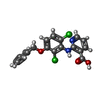+Search query
-Structure paper
| Title | CryoEM structures of the human CLC-2 voltage-gated chloride channel reveal a ball-and-chain gating mechanism. |
|---|---|
| Journal, issue, pages | Elife, Vol. 12, Year 2024 |
| Publish date | Feb 12, 2024 |
 Authors Authors | Mengyuan Xu / Torben Neelands / Alexander S Powers / Yan Liu / Steven D Miller / Grigore D Pintilie / J Du Bois / Ron O Dror / Wah Chiu / Merritt Maduke /  |
| PubMed Abstract | CLC-2 is a voltage-gated chloride channel that contributes to electrical excitability and ion homeostasis in many different tissues. Among the nine mammalian CLC homologs, CLC-2 is uniquely activated ...CLC-2 is a voltage-gated chloride channel that contributes to electrical excitability and ion homeostasis in many different tissues. Among the nine mammalian CLC homologs, CLC-2 is uniquely activated by hyperpolarization, rather than depolarization, of the plasma membrane. The molecular basis for the divergence in polarity of voltage gating among closely related homologs has been a long-standing mystery, in part because few CLC channel structures are available. Here, we report cryoEM structures of human CLC-2 at 2.46 - 2.76 Å, in the presence and absence of the selective inhibitor AK-42. AK-42 binds within the extracellular entryway of the Cl-permeation pathway, occupying a pocket previously proposed through computational docking studies. In the apo structure, we observed two distinct conformations involving rotation of one of the cytoplasmic C-terminal domains (CTDs). In the absence of CTD rotation, an intracellular N-terminal 15-residue hairpin peptide nestles against the TM domain to physically occlude the Cl-permeation pathway. This peptide is highly conserved among species variants of CLC-2 but is not present in other CLC homologs. Previous studies suggested that the N-terminal domain of CLC-2 influences channel properties via a "ball-and-chain" gating mechanism, but conflicting data cast doubt on such a mechanism, and thus the structure of the N-terminal domain and its interaction with the channel has been uncertain. Through electrophysiological studies of an N-terminal deletion mutant lacking the 15-residue hairpin peptide, we support a model in which the N-terminal hairpin of CLC-2 stabilizes a closed state of the channel by blocking the cytoplasmic Cl-permeation pathway. |
 External links External links |  Elife / Elife /  PubMed:38345841 / PubMed:38345841 /  PubMed Central PubMed Central |
| Methods | EM (single particle) |
| Resolution | 2.46 - 4.03 Å |
| Structure data | EMDB-41126, PDB-8ta2: EMDB-41127, PDB-8ta3: EMDB-41128, PDB-8ta4: EMDB-41129, PDB-8ta5: EMDB-41130, PDB-8ta6: |
| Chemicals |  ChemComp-GH6:  ChemComp-CL: |
| Source |
|
 Keywords Keywords | TRANSPORT PROTEIN/INHIBITOR / Chloride / Channel / Inhibitor / Protein / Voltage gated / TRANSPORT PROTEIN-INHIBITOR complex / TRANSPORT PROTEIN |
 Movie
Movie Controller
Controller Structure viewers
Structure viewers About Yorodumi Papers
About Yorodumi Papers













 homo sapiens (human)
homo sapiens (human)